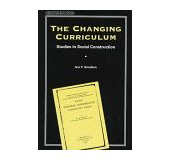The Changing Curriculum: studies in social construction
Chariots of Fire
The normative character of the system is clear and as a result of 'these necessities' the curriculum had 'settled down into an uneasy equilibrium, the demands of specialists and subjects being widely adjusted and compensated' (The Norwood Report 1943, p. 61). The extent to which university examination boards thereby influenced the curriculum through examination subjects is evident. The academic subject- centred curriculum was in fact strengthened in the period following the 1944 Education Act. In 1951 the introduction of the General Certificate of Education allowed subjects to be taken separately at 'O' level (in the School Certificate blocks of 'main' subjects had to be passed); and the introduction of Advanced level increased subject specialisation and enhanced the link between 'academic' examinations and university 'disciplines'. The academic subjects which dominated 'O' and especially 'A' level examinations were then closely linked to university definitions; but even more crucially they were linked to patterns of resource allocation. Academic 'subjects' claiming close connections to university 'disciplines' were for the 'able' students. From the beginning it was assumed that such students required 'more staff, more highly paid staff and more money for equipment and books' (Byrne 1974, p. 29). The crucial and sustained line between 'academic' subjects and preferential resources and status was therefore established.
But if this system was predominant with regard to staffing and resources for academic subjects in grammar schools, the implications for the other schools (and styles of curriculum) should not be forgotten. Echoing Taunton, Norwood in 1943 had discovered that schooling had created distinctive groups of pupils each of which needed to be treated 'in a way appropriate to itself'. This time the social and class basis of differentiation remained the same but the rationale and mechanism for differentiation was significantly different. Before the argument had focussed on time spent at school now the emphasis was on different 'mentalities' each recognising a different curriculum. Firstly 'the pupil who is interested in learning for its own sake, who can grasp an argument or follow a piece of connected reasoning`. Such pupils 'educated by the curriculum commonly associated with grammar schools have entered the learned professions or have taken up higher administrative or business posts'. The second group whose interests lie in the field of applied science or applied arts were to go to technical schools (which never developed very far). Thirdly, the pupils who deal 'more easily with concrete things than with ideas'. The curriculum would 'make a direct appeal to interests, which it would awaken by practical touch with affairs'. A practical curriculum then for a manual occupational future.
